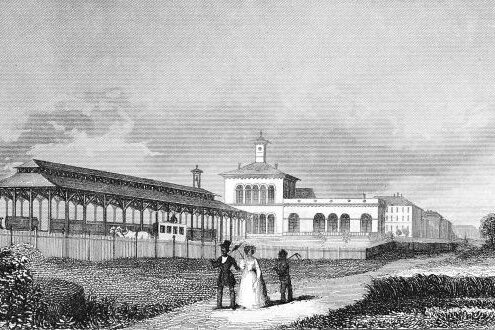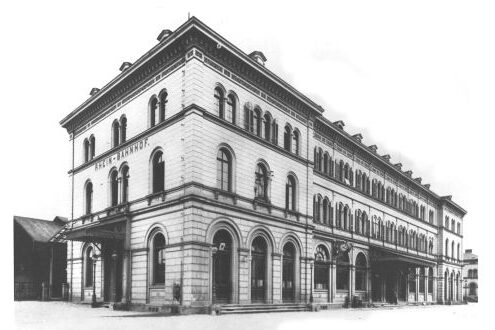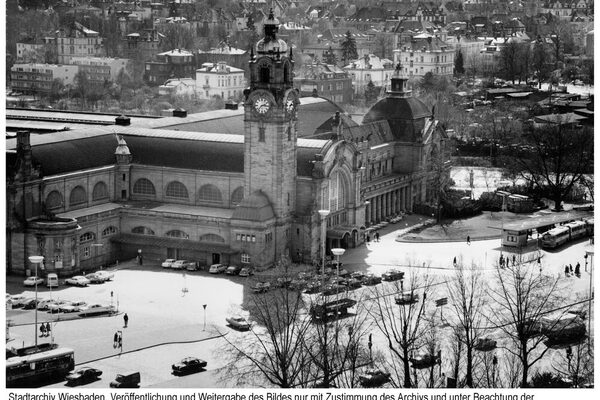Stations
Wiesbaden had been connected to the rail network from Frankfurt by the Taunusbahn since 1840. This was followed by the connections to Rüdesheim and finally the Wiesbaden-Niedernhausen line with the Hessian Ludwig Railway. All three railroad lines initially had their own station in the city.
The first railroad stations in Wiesbaden were concentrated in the south of the historic pentagon on Rheinstraße. Initially, the Taunusbahnhof was built in 1840 as the terminus of the Taunusbahn from Frankfurt. With its head building and small platform hall, it resembled the Taunus station in Frankfurt. Immediately to the west of this, the station on the right bank of the Rhine towards Rüdesheim was added in 1857. The neo-classical reception building of the so-called Rheinbahnhof was not completed until 1868. In contrast to the Taunus station, it was not designed as a head building facing Rheinstraße, but parallel to the tracks. Nothing remains of either station today; their sites have been absorbed into the Rhein-Main-Hallen.
In 1879, the Hessische Ludwigsbahn opened the line to Niedernhausen. In contrast to the two stations mentioned above, it did not build a new station building, but took over an existing villa for its purposes. The Wiesbaden Museum has occupied the site of the Ludwigsbahn station since 1915. From 1889, the Rheinbahnhof also took trains from the Aartalbahn to Langenschwalbach, now Bad Schwalbach.
This arrangement of three terminus stations directly next to each other, which were built by three different operators, is basically typical of the early phase of the railroad system and can be observed in many larger cities in Germany during this period. As elsewhere, the three stations proved to be cramped and inefficient. Changing from one station to another was cumbersome and time-consuming. To make matters worse, local freight traffic was spread across the three stations.
A special feature of Wiesbaden was that long-distance trains on the Taunusbahn and the right bank of the Rhine bypassed Wiesbaden; as a rule, the cosmopolitan spa town was only connected to long-distance services by scheduled coaches, which were attached to or detached from the through trains at the "Curve" station - today's Wiesbaden Ost station - or Biebrich-Mosbach. This was one of the problematic consequences for Wiesbaden of the operationally inadequate stations on the Rheinstraße.
The situation was made more difficult by the conflict that arose from 1880 between the Prussian state railway administration, which included the right bank of the Rhine from 1866 and the Taunusbahn from 1872, and the Hessische Ludwigsbahn (railroad) based in Mainz. Although these disputes did not gain anywhere near the intensity and relevance as in Frankfurt, they were nevertheless partly responsible for the completely unsatisfactory station conditions from Wiesbaden's point of view. Even the joint nationalization of the Ludwigsbahn by Prussia and Hesse-Darmstadt in 1896/97, as a result of which Prussia became the sole operator of railroads in Wiesbaden, did not initially bring about any improvement. Obviously, the state railway administration delayed a comprehensive restructuring of the railroad facilities in and around Wiesbaden.
Only the initiative of Lord Mayor Carl Bernhard von Ibell, who was able to interest the Emperor in the Wiesbaden railroad station issue thanks to his excellent relations with Wilhelm II, brought about a turnaround from 1896: A comprehensive redesign process now began to take shape, which had in any case become increasingly unavoidable in connection with the construction of the Mainz bypass railroad and, linked to this, the Kaiserbrücke. The core of the major redesign, which was completed by the end of 1906, was the abandonment of the three old stations on the Rheinstraße and their replacement by a generously designed new main station that was 700 m further south than the old stations.
This main station was designed as a terminus station. Its construction on the west side of the Salzbachtal valley proved to be difficult, as there were considerable landslides in the area of the Melonenberg. Despite the generous dimensions of its operating facilities, passenger trains traveling from Cologne to Frankfurt or Mainz had to take a detour from the previous route from Biebrich-Mosbach on the right bank of the Rhine directly to the "Curve" station on the Taunusbahn. The obligatory, time-consuming change of direction and locomotive in a terminus station made things even more difficult.
However, it was only under the aegis of the German Federal Railways that a gradual shift of through passenger trains from Wiesbaden main station to Mainz took place over decades. Since its opening in 1906, this has been problematized and the construction of a terminus station has been characterized as a wrong decision. A through station in Biebrich was repeatedly proposed as a replacement. In this debate, the natural characteristics of Wiesbaden's urban area in a valley basin that is fundamentally not conducive to railroad construction have almost always been overlooked. Furthermore, the fact that such a plan would create a central station for Biebrich and eliminate one for Wiesbaden was ignored. The abandonment of terminus stations by the Bundesbahn in Heidelberg (1955), Braunschweig (1960), Ludwigshafen (1969) and Kempten (1969) and their replacement in each case by modern but peripherally located through stations meant that it took decades (Heidelberg) or not at all (Braunschweig, Ludwigshafen, Kempten) for the new station facilities to be connected to the city centers in terms of urban development. In this respect, the decision in favor of a terminus station in Wiesbaden can also be considered objectively justified from today's perspective. The shift to the south compared to the old stations was accompanied by large-scale urban redevelopment such as the construction of the First Ring.
Ambitious plans for urban development on the site of the abandoned stations were unsuccessful, not least because of the First World War. Although the Reisinger and Herbert parks created on the former railroad site in the interwar period offer travelers exiting the main station a magnificent entrance that is unique in Germany, they cannot hide the fact that even the relocation of the station in 1906 has still not been a complete success in terms of urban development.
With the construction of the new main station, the relocation of the Aartalbahn had become unavoidable. As early as May 2, 1904, the section of line via northern Biebrich with the stations Nassauisches Landesdenkmal and Waldstraße to the main line near Dotzheim was put into operation, which gave the Aartalbahn a detour projecting to the south that significantly impaired the traffic value of the branch line. This was associated with the construction of a connecting line, opened in sections on November 28, 1904 and October 1, 1906, from the "Curve" station via Waldstraße station to the newly created Wiesbaden West freight station in the west of the city on Dotzheimer Straße near Kleinfeldchen.
With this new, generously dimensioned station, it was possible to completely remove local freight traffic from the city center, with the exception of the quantitatively less significant express freight traffic that remained at the main station. This approach was very problematic for rail operations, as the connecting line from the "Curve" to the Westbahnhof station is steep. Due to the peculiarities of Wiesbaden's economic structure, incoming goods very much outweighed outgoing goods, which is why freight trains to and from the Westbahnhof had to travel on the steep line in the direction of the load. While the main station is situated at an altitude of 108 m, the western station was 153 m above sea level. After decades of decline in the post-war period, the site of the now demolished Westbahnhof is currently being redeveloped into the artists' quarter.
The oldest station buildings in the city of Wiesbaden can be found in Biebrich and Schierstein on the right bank of the Rhine. They were built in simple neoclassical style around 1860 and thus date back to the Nassau era. The station buildings of the Ostbahnhof in Biebrich on the border with Amöneburg and the station buildings of the Aartalbahn in Biebrich (Landesdenkmal, Waldstraße) and Dotzheim date from the time of the major redesign of the railroad facilities in and around Wiesbaden at the turn of the century. Of the stations on the line to Niedernhausen(Erbenheim, Igstadt, Auringen-Medenbach) located in the city of Wiesbaden, only Igstadt still has a station with a station building, which was built in the 1920s. While the Wiesbaden stations on the right bank of the Rhine (Biebrich, Schierstein) and on the Niedernhausen line are used exclusively for local passenger services, local and the remaining long-distance passenger services are concentrated at the main station. The Ostbahnhof is served by the S-Bahn lines touching Wiesbaden and is otherwise used for freight traffic. The station in Kastel on the Taunusbahn no longer plays a role in either freight or long-distance passenger traffic, but has attractive local connections with Wiesbaden and Frankfurt. Its station building from 1955, which replaced the previous Wilhelmine building destroyed in the Second World War, is an example of the functional and functional design language of the reconstruction architecture.
Literature
- Kopp, Klaus
Langenschwalbacher Bahn (Aartalbahn). On the history of the famous Nassau region railroad. Schriften des Heimat- und Verschönerungsvereins Dotzheim e. V., No. 16, Wiesbaden 1994.
- Hager, Bernhard
"A magnificent building, and a modern one". 100 years of Wiesbaden Central Station. In: Yearbook of Railway History, Volume 38, Hövelhof 2006 (pp. 5-24).



